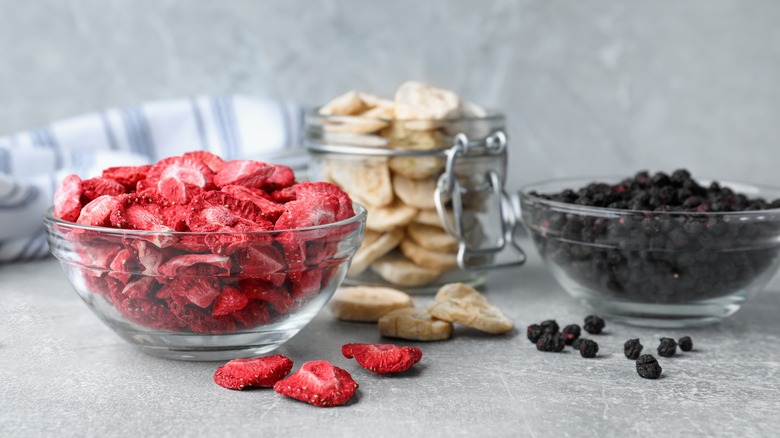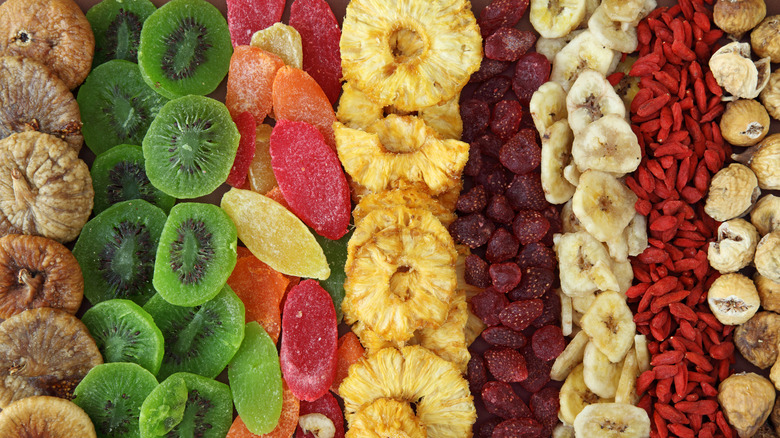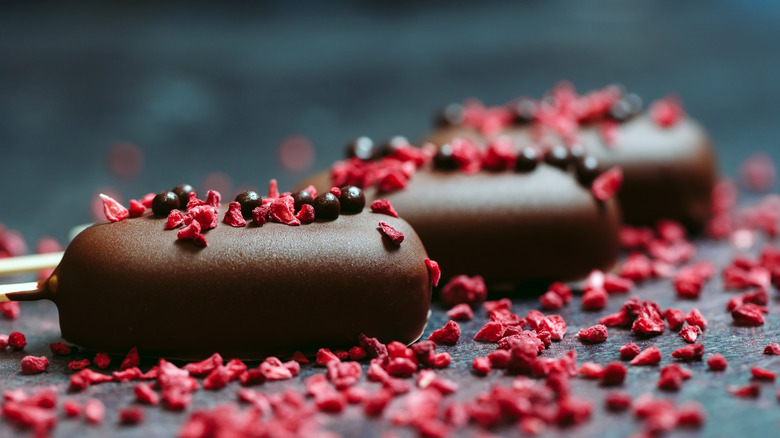You Should Always Have Freeze-Dried Fruit In Your Pantry. Here's Why
Freeze-dried food is so much more than just astronaut ice cream. When you purchase fresh berries and fruit, the use-it-or-lose-it clock is already ticking, which is why we have a variety of ways to preserve that fruit. You can pickle, can, or dehydrate fresh fruit at home, or you may choose to keep freeze-dried or dehydrated fruit in the pantry so you have it ready to go when you need it. Each preservation method affects fruit differently, though, so understanding how the fruit is processed can help you determine how best to use it.
The process of freeze drying is called lyophilization, which Base Camp Food explains is a preservation method that renders food and other biological materials to a shelf-stable state that doesn't require refrigeration, so it's particularly useful for portable foods, pharmaceuticals, and other substances that are heat-sensitive.
Freeze drying fruit occurs in three stages, according to the Khoshbin Group. First, fresh fruit is flash-frozen to a temperature of -54 degrees Fahrenheit, which quickly crystallizes water while preserving the fruit's structure. Next, the air pressure is reduced, which causes the crystallized water to sublimate, or turn from a solid directly into a gas, skipping its liquid phase. Finally, the temperature is increased, further dehydrating the fruit until only one to two percent of the water remains.
Both freeze-dried and dehydrated fruit rely on decreasing water content for preservation, making it easy to confuse the two methods, but there are important differences to keep in mind in the kitchen.
Freeze-dried vs. dehydrated fruit
It turns out all dried fruit isn't created equal! Dehydration, as the Khoshbin Group explains, relies on heat, typically in the 284-338 degrees Fahrenheit range, and Crispy Green points out a number of differences between dehydrated and freeze-dried fruits. First, the use of heat alters the flavor of dehydrated fruit, while freeze-drying preserves the flavor of fresh fruit because only the water is removed and the fruit is never heated. Dehydrated fruit retains more moisture — about one-third of the original moisture content of fresh fruit — which means its shelf life is shorter than that of freeze-dried fruit.
Crispy Green also notes that dehydrated fruit often relies on preservatives to extend its shelf life, while freeze-dried fruit does not. Additionally, freeze-dried fruit retains nearly all the nutritional value of fresh fruit, while the heat required for dehydrating fruit causes it to lose nutrients. And finally, the textures of dehydrated and freeze-dried fruits are completely different. Dehydrated fruit is chewy, while freeze-dried fruit is crisp and crunchy. Which texture you like better may come down to personal preference, but there are a few more advantages to keeping freeze-dried fruit in your pantry that should not be overlooked.
Cooking with freeze-dried fruit
You should consider keeping freeze-dried fruit in your pantry because, as Freshly Preserved points out, it's practically weightless, so it's as easily portable as you can get. If you want fruit to snack on, freeze-dried won't weigh you (or your bags) down. Not only does it not take up a lot of space, but you also don't have to worry about it going bad, as it has a shelf life of a staggering 25 years, per Khoshbin Group.
But the cooking — and particularly the baking — applications of freeze-dried fruits are where they really shine. The Washington Post explains that since freeze-dried fruit won't alter the moisture content of your recipe, you can throw it in with abandon. Green Matters notes that freeze-dried fruit usually contains just the fruit's natural sugars, so it won't make your recipes overly sweet, and King Arthur Baking adds that the freeze-drying process also concentrates the fruit's natural citric acid, giving it a delightful tanginess that perks up baked goods.
And since freeze-dried fruit is crunchy, you can whizz it up in a food processor to create a powder, which can be used for flavoring and coloring everything from muffins to macarons. Freeze-dried fruit can be sprinkled on a salad or used to coat decadent handmade truffles. Even recipes like frosting and flavored whipped cream, where achieving the perfect texture can be a challenge, can benefit from the flavor and color boost of freeze-dried fruit.


